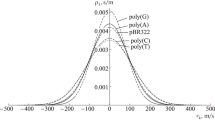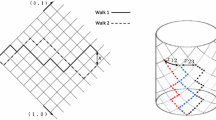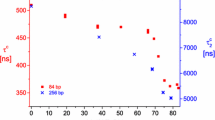Abstract.
We study the effect of the composition of the genetic sequence on the melting temperature of double stranded DNA, using some simple analytically solvable models proposed in the framework of the wetting problem. We review previous work on disordered versions of these models and solve them when there were not preexistent solutions. We check the solutions with Monte Carlo simulations and transfer matrix numerical calculations. We present numerical evidence that suggests that the logarithmic corrections to the critical temperature due to disorder, previously found in RSOS models, apply more generally to ASOS and continuous models. The agreement between the theoretical models and experimental data shows that, in this context, disorder should be the crucial ingredient of any model while other aspects may be kept very simple, an approach that can be useful for a wider class of problems. Our work has also implications for the existence of correlations in DNA sequences.
Similar content being viewed by others
References
D. Poland, H.A. Scheraga, J. Chem. Phys. 45, 1456 (1966); D. Poland, H.A. Scheraga, J. Chem. Phys. 45, 1464 (1966); D. Poland, Biopolymers 73, 216 (2004); C. Richard, A.J. Guttmann, J. Stat. Phys. 115, 925 (2004)
M. Peyrard, A.R. Bishop, Phys. Rev. Lett. 62, 2755 (1989)
T. Dauxois, M. Peyrard, A.R. Bishop, Phys. Rev. E 47, R44 (1993); T. Dauxois, M. Peyrard, Phys. Rev. E 51, 4027 (1995)
L.V. Yakushevich, Nonlinear Models of DNA, 2nd edn. (Wiley, 2004)
C.H. Choi, G. Kalosakas, K.Ø. Rasmussen, M. Hiromura, A.R. Bishop, A. Usheva, Nucleic Acids Res. 32, 1584 (2004); G. Kalosakas, K.Ø. Rasmussen, A.R. Bishop, C.H. Choi, A. Usheva, Europhys. Lett. 68, 127 (2004)
T.S. van Erp, S. Cuesta-López, J.-G. Hagmann, M. Peyrard, Phys. Rev. Lett. 95, 218104 (2005)
S. Ares, N.K. Voulgarakis, K.Ø. Rasmussen, A.R. Bishop, Phys. Rev. Lett. 94, 035504 (2005)
A. Montrichok, G. Gruner, G. Zocchi, Europhys. Lett. 62, 452 (2003); Y. Zeng, A. Montrichok, G. Zocchi, Phys. Rev. Lett. 91, 148101 (2003); Y. Zeng, A. Montrichok, G. Zocchi, J. Mol. Biol. 339, 67 (2004)
S.T. Chui, J.D. Weeks, Phys. Rev. B 23, R2438 (1981)
J.M.J. van Leeuwen, H.J. Hilhorst, Physica A 107, 319 (1981)
T.W. Burkhardt, J. Phys. A 14, L63 (1981)
J.A. Cuesta, A. Sánchez, J. Stat. Phys. 115, 869 (2004)
G. Forgacs, J.M. Luck, Th.M. Nieuwenhuizen, H. Orland, Phys. Rev. Lett. 57, 2184 (1986); J. Stat. Phys. 51, 29 (1988)
B. Derrida, V. Hakim, J. Vannimenus, J. Stat. Phys. 66, 1189 (1992)
S.M. Bhattacharjee, S. Mukherji, Phys. Rev. Lett. 70, 49 (1993); S. Mukherji, S.M. Bhattacharjee, Phys. Rev. E 48, 3483 (1993)
T.W. Burkhardt, J. Phys. A 31, L549 (1998)
P. Nowakowski, M. Napiórkowski, J. Phys. A 38, 5885 (2005)
T. Dauxois, M. Peyrard, A.R. Bishop, Phys. Rev. E 47, 684 (1993)
J. Marmur, P. Doty, J. Mol. Biol. 5, 109 (1962)
Monte Carlo simulations have been done following the procedure described in MC2. 5×105 tries of replica exchange are used, and between them each replica is simulated a number of Monte Carlo steps equal to the energy autocorrelation time at the replica's temperature, determined during previous simulations used for equilibration
S. Ares, J.A. Cuesta, A. Sánchez, R. Toral, Phys. Rev. E 67, 046108 (2003)
N. Metropolis, A.W. Rosenbluth, M.N. Rosenbluth, A.H. Teller, E. Teller, J. Chem. Phys. 21, 1087 (1953)
M.E.J. Newman, G.T. Barkema, Monte Carlo Methods in Statistical Physics (Oxford University, Oxford, 1999)
Y. Iba, Int. J. Mod. Phys. C 12, 623 (2001)
S. Ares, A. Sánchez, Phys. Rev. E 70, 061607 (2004)
A. Campa, A. Giansanti, Phys. Rev. E 58, 3585 (1998)
S. Ares, A. Sánchez, unpublished data
B.H. Park, M. Levitt, J. Mol. Biol. 249, 493 (1995)
M.E.J. Newman, SIAM Rev. 45, 167 (2003)
K. Binder, A.P. Young, Rev. Mod. Phys. 58, 801 (1986)
W. Li, Computers Chem. 21, 257 (1997)
Author information
Authors and Affiliations
Corresponding author
Rights and permissions
About this article
Cite this article
Ares, S., Sánchez, A. Modelling disorder: the cases of wetting and DNA denaturation. Eur. Phys. J. B 56, 253–258 (2007). https://doi.org/10.1140/epjb/e2007-00112-9
Received:
Published:
Issue Date:
DOI: https://doi.org/10.1140/epjb/e2007-00112-9




